Thrane and Thrane A S TT 3965A User Manual
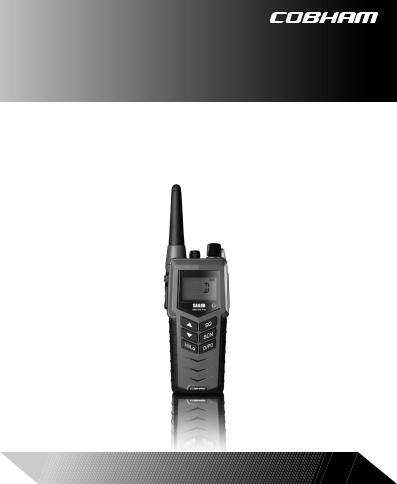
SAILOR 3965 Portable UHF ATEX, Fire Fighter
User manual

Disposal
The Waste Electrical and Electronic Equipment (WEEE) Directive aims to minimise any adverse impact of electronic equipment on the environment, both during the product lifetime and when it becomes waste. Within the European Union this legislation is mandated by Directive 2012/19/EU, and there is similar legislation in most other continents. The directive applies to all electronic products such as IT, household appliances, portable electronics etc., and imposes requirements to collect, treat, recover and recycle each product at its end of life. Electronic end-user products must also carry a WEEE label (as below) and recovery and recycling information has to be provided to the recycler.
This product contains traces of lithium in the battery pack. In addition it may contain lead and brominated flame retardants (BFRs), both in the housing material and circuit boards. In keeping with the directive,
Thrane & Thrane A/S strongly recommends that this product and its battery pack be disposed of in a sensible and considerate manner. For example, do not simply discard the product in the domestic waste. Instead take it to a civil recycling facility, or contact Thrane & Thrane A/S for advice.
Attention
Read important ATEX information in the following 9 pages. Additional important user information follows after page 9.
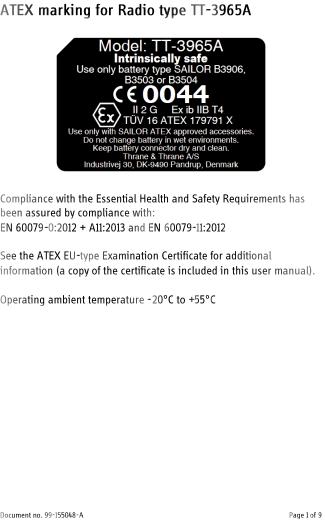
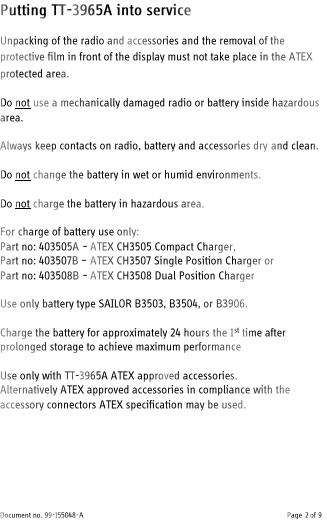
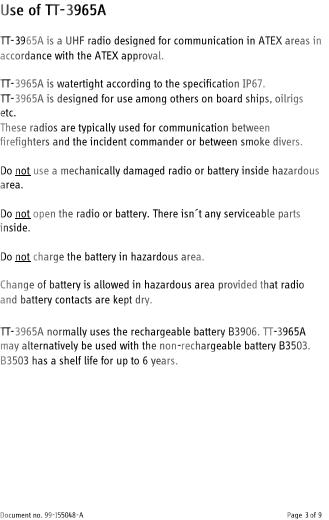
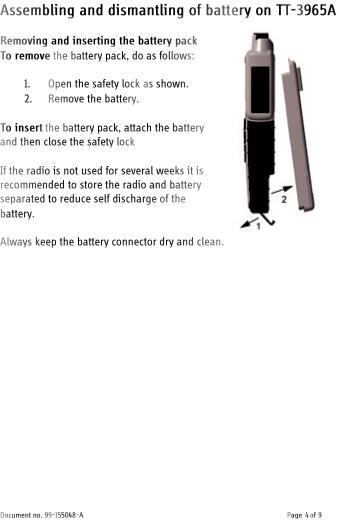
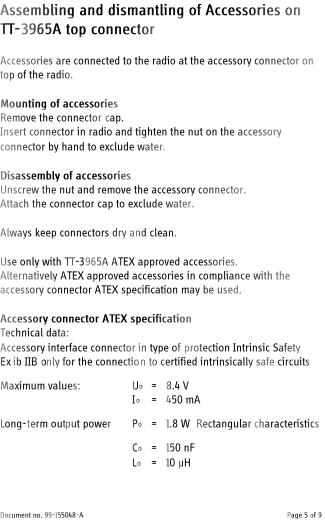
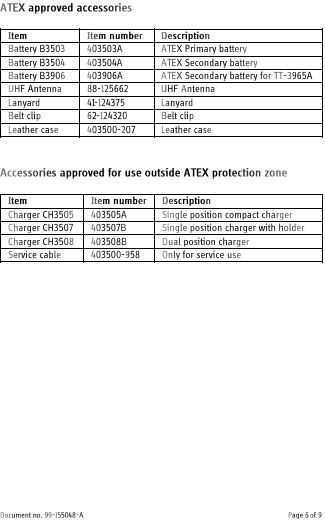
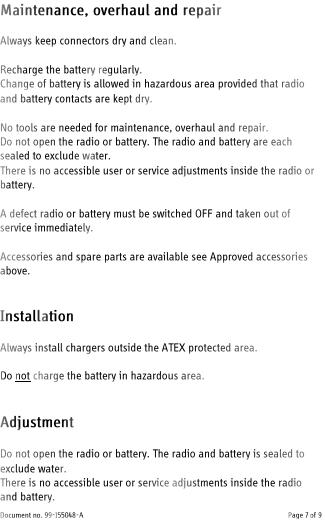

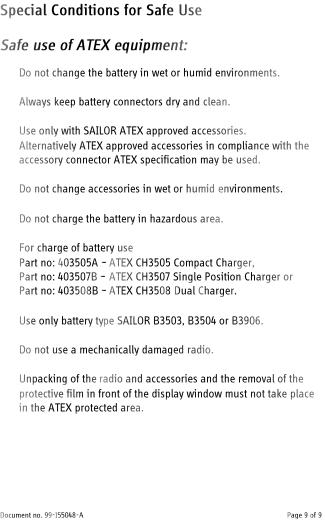
SAILOR 3965 ATEX UHF Fire
Document number: 98-150078-G_Draft 03
Release date: June 15, 2018
Copyright: © 2018 Thrane & Thrane A/S. All rights reserved.
Trademark Acknowledgements
•SAILOR is a registered trademark of Thrane & Thrane A/S.
•Other product and company names mentioned in this manual may be trademarks or trade names of their respective owners.
Warranty limitation
IMPORTANT - The radio and batteries are sealed waterproof units. To create and maintain the waterproof integrity they are assembled in a controlled environment using special equipment. The radio and batteries are not user maintainable units, and the units must under no circumstances be opened except by authorized personnel. Unauthorized opening of the units will invalidate the warranty.
Disclaimer
Any responsibility or liability for loss or damage in connection with the use of this product and the accompanying documentation is disclaimed by Thrane & Thrane A/S. The information in this manual is provided for information purposes only, is subject to change without notice and may contain errors or inaccuracies. Manuals issued by Thrane & Thrane A/S are periodically revised and updated. Anyone relying on this information should acquire the most current version e.g. from www.cobham.com/satcom, Cobham SYNC Partner Portal, or from the distributor. Thrane & Thrane A/S is not responsible for the content or accuracy of any translations or reproductions, in whole or in part, of this manual from any other source. In the event of any discrepancies, the English version shall be the governing text.
Thrane & Thrane A/S is trading as Cobham SATCOM.
1824 |
i |

Precautions
Avoid water and salt in the I/O connector and keep it dry and clean.
Only use original Thrane & Thrane battery packs. Make sure they are clean and dry before attaching the transceiver.
Be careful not to damage any gaskets.
Only use the original Thrane & Thrane charger for the rechargeable battery.
Be very careful when handling the Lithium batteries. With correct use they are safe but any misuse might cause dangerous situations.
Do not short circuit the battery terminals, or expose the transceiver and the batteries to extreme temperature or fire.
Beware of RF exposure. Read section RF exposure and safety on page iii, Training Requirement on page iii and Operating instruction on page iv before using this radio.
Do not submerge the transceiver more than 1 m for 30 minutes. Keep the transceiver at least 0.3 m away from the magnetic compass.
ii |
1824 |
RF exposure and safety
The SAILOR 3965 ATEX UHF Fire is designed for occupational use only and is also classified as such. It must be operated by licensed personnel only and thus NOT intended for use in an uncontrolled environment by general public.
The SAILOR 3965 ATEX UHF Firefighter must only be used in the course of employment by individuals aware of the radiation hazards as well as the way to minimize those.
This radio complies with the limits for occupational/controlled RF exposure environment at operating duty factors of up to 50% transmitting and is authorized for occupational use only.
To control your exposure and ensure compliance with the occupational/controlled environment exposure limits always adhere to the following procedures.
•User awareness instructions should accompany device when transferred to other users.
•Do not use this device if the operational requirements described herein are not met.
The SAILOR 3965 ATEX UHF Firefighter complies with the limits for occupational/controlled exposure in the following SAR specifications:
•IEEE 1528-2013
•FCC CFR 47 § 2.1093
•RSS-102 Issue 5
Training Requirement
Operating personnel shall have completed an RF safety program including specific training and education regarding RF radiation hazards in the use of the equipment.
Please refer to the following websites for more information on what RF energy exposure is and how to control your exposure to assure compliance with established RF exposure limits.
https://www.fcc.gov/engineering-technology/electromagnetic-compatibility- division/radio-frequency-safety/faq/rf-safety
http://www.ic.gc.ca/eic/site/ceb-bhst.nsf/eng/h_tt00084.html
1824 |
iii |
Operating instruction
Follow these general rules of operation for safe operation and to reduce the RF exposed energy:
•Transmit no more than the rated duty factor of 50% of the time.
•Hold the radio in a vertical position in front of face with the microphone (and the other parts of the radio, including the antenna) at least one inch (2.5 cm) away from the head. Keeping the radio at the proper distance is important because RF exposures decrease with distance from the antenna.
•When worn on the body, always place the radio with an approved belt clip or case. Using approved body-worn accessories is important because the use of other manufacturer’s non-approved accessories may result in exposure levels, which exceed the occupational/controlled environment RF exposure limits.
•Use only manufacturer’s name approved supplied or replacement antennas, batteries, and accessories. Use of non-manufacturer-name approved antennas, batteries, and accessories may exceed the exposure guidelines.
•For best radio performance, hold the radio vertically and 5 cm away from the head when talking into the microphone.
Channel programming
SAILOR 3965 ATEX UHF Fire is from manufacturer programmed with an approved set of 25 kHz and 12.5 kHz channels according to ITU-R M.1174-3 specifying the international channels for on-board vessel communication. For alternative configuration of the radio contact a general agent.
“Placeholder” for French version of Precautions, RF exposure and safety, Training Requirement, Operating instruction and Channel programming.
iv |
1824 |

|
Contents |
|
Chapter 1 |
Introduction |
|
|
Your ATEX UHF Fire .............................................................. |
1 |
|
Performance ........................................................................ |
2 |
|
Channels ............................................................................. |
2 |
Chapter 2 |
Operation |
|
|
Controls ............................................................................... |
5 |
|
Keys and buttons ................................................................ |
5 |
|
The display ......................................................................... |
7 |
|
Using the ATEX UHF ............................................................ |
8 |
|
Basic functions .................................................................. |
8 |
|
Other functions ................................................................... |
11 |
Chapter 3 |
Batteries |
|
|
Battery level indication ..................................................... |
15 |
|
The battery chargers ......................................................... |
16 |
|
Installing the charger ....................................................... |
16 |
|
Recharging the battery ...................................................... |
17 |
Chapter 4 |
Configuring the radio |
|
|
Configuration mode ............................................................ |
19 |
|
Entering and using configuration mode ............................ |
19 |
|
List of configuration settings ............................................. |
20 |
1616 |
vii |

Chapter 5 Equipment and accessories |
|
|
|
External equipment ........................................................... |
27 |
|
List of equipment .............................................................. |
27 |
|
Connecting external equipment ........................................ |
28 |
|
Impact on radio operation ................................................ |
29 |
|
Accessorie connector ........................................................ |
29 |
|
Accessories ....................................................................... |
30 |
|
List of accessories ............................................................. |
30 |
|
Attaching and removing the belt clip ................................ |
32 |
|
Attaching the lanyard ....................................................... |
32 |
Chapter 6 |
Troubleshooting |
|
|
Displaying errors .............................................................. |
33 |
App. A |
Technical specifications |
|
|
Technical data SAILOR 3965 .............................................. |
35 |
|
General ............................................................................ |
35 |
|
Transmitter ....................................................................... |
36 |
|
Receiver ........................................................................... |
36 |
|
Battery life guidelines ........................................................ |
37 |
|
Battery (rechargeable) ..................................................... |
37 |
|
Dimensional drawing, transceiver ................................. |
38 |
|
Dimensional drawing, charger .......................................... |
39 |
|
Declaration of Conformity .................................................. |
41 |
App. B |
Attention |
|
|
Gore-tex Membrane .......................................................... |
47 |
viii |
1616 |
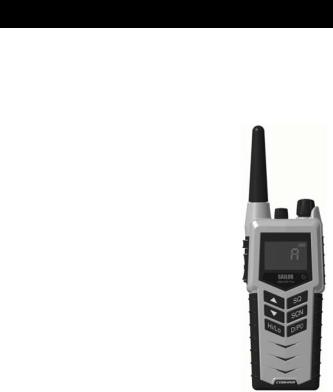
Chapter 1
Introduction
Your ATEX UHF Fire
The ATEX UHF Fire is designed for flexibility in daily use. It connects easily to external equipment like headsets and fist mikes, making the SAILOR 3965 suitable for any noisy environment.
Main features:
Unique man machine interface, an excellent grip even with gloves, and large tactile buttons.
Display with red adjustable backlight which makes the display visible even at night.
Built-in “sleep” function, minimizing power consumption and improving battery lifetime.
Selectable 12.5 kHz narrow band or 25 kHz wide band operation.
Scrambling function for privacy calls.
CTCSS function for selective opening of Squelch.
Channel read-out function for audible feedback of channel name in headset upon channel change
A lanyard and belt clip included.
1616 |
1 |

Introduction
Performance
For best performance of the transceiver keep the following in mind:
•Keep clear of metal environment.
•Hold the transceiver vertically and 5 cm from lips and push the PTT when transmitting.
•In receive mode carry the transceiver vertically with belt clips.
•To preserve battery power, adjust squelch to close the loudspeaker when there is no signal.
•If you are in a lifeboat keep the antenna as high as possible.
Channels
SAILOR 3965 ATEX UHF Fire is from manufacturer programmed with an approved set of 25 kHz and 12.5 kHz channels according to ITU-R M.1174-3 specifying the international channels for on-board vessel communication. For alternative configuration of the radio contact a general agent.
Table 1: Simplex frequencies (25 kHz or 12.5 kHz(n) use)
Channel designator |
Recommendation ITU-R |
Frequency |
|
(preprogrammed) |
M.1174-3 |
||
|
|||
A |
4 |
467.525 MHz |
|
|
|
||
An |
21 |
||
|
|||
B |
5 |
467.550 MHz |
|
|
|
||
Bn |
23 |
||
|
|||
C |
6 |
467.575 MHz |
|
|
|
||
Cn |
25 |
||
|
2 |
1711 |

Introduction
Channel designator |
Recommendation ITU-R |
Frequency |
|
(preprogrammed) |
M.1174-3 |
||
|
|||
D |
1 |
457.525 MHz |
|
|
|
||
Dn |
11 |
||
|
|||
E |
2 |
457.550 MHz |
|
|
|
||
En |
13 |
||
|
|||
F |
3 |
457.575 MHz |
|
|
|
||
Fn |
15 |
||
|
Table 2: Additional frequencies for 12.5 kHz use
Channel designator |
Recommendation ITU-R |
Frequency |
|
(preprogrammed) |
M.1174-3 |
||
|
|||
Mn |
22 |
467.5375 MHz |
|
Nn |
24 |
467.5625 MHz |
|
On |
12 |
457.5375 MHz |
|
Pn |
14 |
457.5625 MHz |
Table 3: Duplex frequencies for use with repeaters only (25 kHz or 12.5 kHz(n) use)
Channel designator |
Repeater RX Frequency |
Repeater TX Frequency |
|
(preprogrammed) |
|||
|
|
||
G |
467.525 MHz |
457.525 MHz |
|
|
|||
Gn |
|||
|
|
||
H |
467.550 MHz |
457.550 MHz |
|
|
|||
Hn |
|||
|
|
1711 |
3 |
